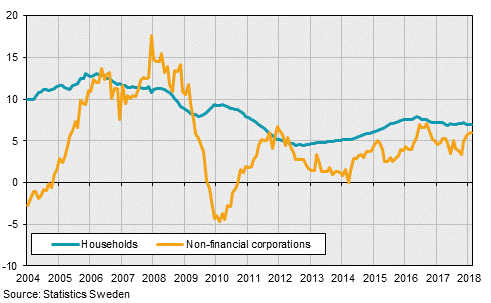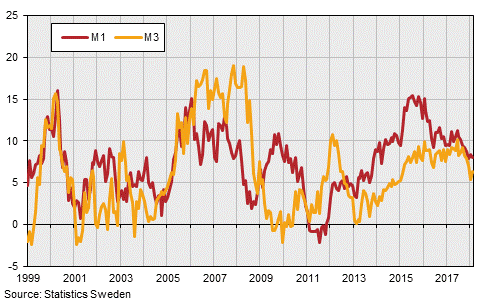Financial market statistics, March 2018:
Growth rate for households’ housing loans unchanged
Statistical news from Statistics Sweden 2018-04-27 9.30
In March 2018, the annual growth rate of households’ housing loans from monetary financial institutions (MFIs) was 7.2 percent, which means it was unchanged from February. Housing loans make up 82 percent of MFIs’ total lending to households and amounted to SEK 3 161 billion in March. The annual growth rate for MFIs’ total lending to households decreased by 0.1 percentage point and amounted to 6.9 percent.
Households’ loans from MFIs totalled SEK 3 855 billion in March, an increase of SEK 20 billion compared with the previous month and SEK 236 billion compared with the corresponding month last year. Housing loans increased by SEK 16 billion compared with the previous month and by SEK 209 billion compared with the corresponding month last year.
The growth rate of households’ consumption loans was 7.4 percent in March, a decrease of 0.3 percentage points compared with February. The growth rate for loans with other collateral was 5.0 percent in March, an increase of 0.1 percentage point compared with February. Households’ consumption credits and loans with other collateral totalled SEK 210 billion and SEK 484 billion respectively in March.

Growth rate for loans to corporations increased
In March, the annual growth rate for loans to non-financial corporations was 6.2 percent, an increase of 0.2 percentage points compared with February. Lending by MFIs to non-financial corporations totalled SEK 2 224 billion in March.
Multi-dwelling buildings is the most common form of collateral for lending to non-financial corporations and amounted to SEK 732 billion in March. Unsecured credit to enterprises amounted to SEK 384 billion and loans to tenant-owner associations, which are considered non-financial corporations, amounted to SEK 466 billion.
Slight increase in housing loan rates
Households’ average housing loan rate for new agreements was 1.56 percent in March, an increase of 0.01 percentage point compared with February. The floating interest rate for housing loans also increased by 0.01 percentage point and amounted to 1.53 percent.
In March, households’ average interest rate for new bank deposits in bank accounts was 0.07 percent, which means it has remained unchanged since January. The interest rate on accounts with fixed periods or a limited number of free withdrawals amounted to 0.12 percent in March.
The average interest rate for loans for new agreements to non-financial corporations rose from 1.30 percent in February to 1.33 percent in March. The floating rate, in turn, increased by 0.09 percentage points compared with the previous month and amounted to 1.36 percent in March.
Non-financial corporations’ average interest rate for new bank deposits in bank accounts amounted to 0.01 percent in March, which means it has remained at the same level since December 2016. The interest rate on accounts with fixed periods or a limited number of free withdrawals was -0.12 percent in March, unchanged compared with February.
| Interest rate, new agreements to households | Households' interest rates for housing loans for new agreements | Growth rate, lending to households | Interest rate, new agreements to non-financial corporations | Growth rate, lending to non- financial corporations | |
|---|---|---|---|---|---|
|
Mar-17
|
1.88% | 1.59% | 7.2% | 1.33% | 5.3% |
|
Feb-18
|
1.87% | 1.55% | 7.0% | 1.30% | 6.0% |
|
Mar-18
|
1.87% | 1.56% | 6.9% | 1.33% | 6.2% |
Growth rate for M3 unchanged
The annual growth rate for the narrow monetary aggregate, M1, amounted to 6.7 percent in March, which is a decrease compared with February, when it was 8.0 percent. M1 amounted to SEK 2 773 billion in March.
The annual growth rate for the broad monetary aggregate, M3, was 6.4 percent in March, which means it remained unchanged compared with February. M3 totalled SEK 3 338 billion in March.

M1 consists of the general public’s holdings of bank notes and coins as well as demand deposits by the general public in MFIs and with the central government. In addition to the M1, the M3 includes deposits with certain conditions, repos, shares in money market funds, and short-term securities.
Definitions and explanations
Statistics Sweden compiles monthly financial market statistics on behalf of the Riksbank. These statistics are based mainly on reporting by monetary financial institutions (MFIs). The MFI sector consists of banks, housing credit institutions, finance companies, institutions financing municipalities and companies, monetary securities companies and monetary investment funds (money market funds).
Next publishing will be
2018-05-29 at 09:30.
Statistical Database
More information is available in the Statistical Database
Feel free to use the facts from this statistical news but remember to state Source: Statistics Sweden.
